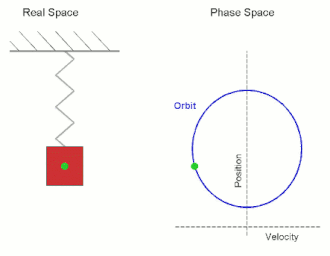
Back فضاء الطور Arabic Espai de fases Catalan Fázový prostor Czech Faserum Danish Phasenraum German Faza spaco Esperanto Espacio fásico Spanish فضای فاز Persian Espace des phases French מרחב פאזה HE

| Differential equations |
|---|
| Scope |
| Classification |
| Solution |
| People |
The phase space of a physical system is the set of all possible physical states of the system when described by a given parameterization. Each possible state corresponds uniquely to a point in the phase space. For mechanical systems, the phase space usually consists of all possible values of the position and momentum parameters. It is the direct product of direct space and reciprocal space.[clarification needed] The concept of phase space was developed in the late 19th century by Ludwig Boltzmann, Henri Poincaré, and Josiah Willard Gibbs.[1]
- ^ Nolte, D. D. (2010). "The tangled tale of phase space". Physics Today. 63 (4): 33–38. Bibcode:2010PhT....63d..33N. doi:10.1063/1.3397041. S2CID 17205307.